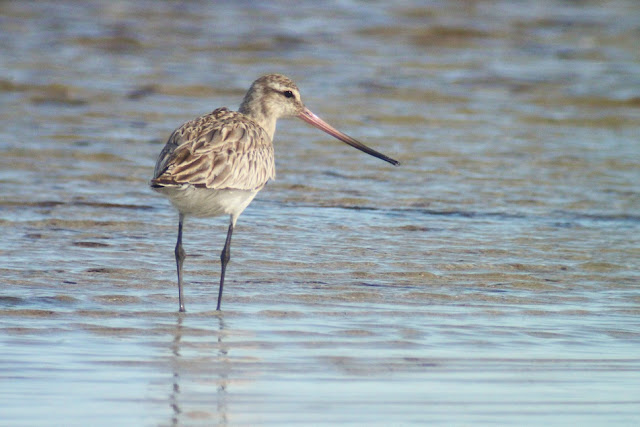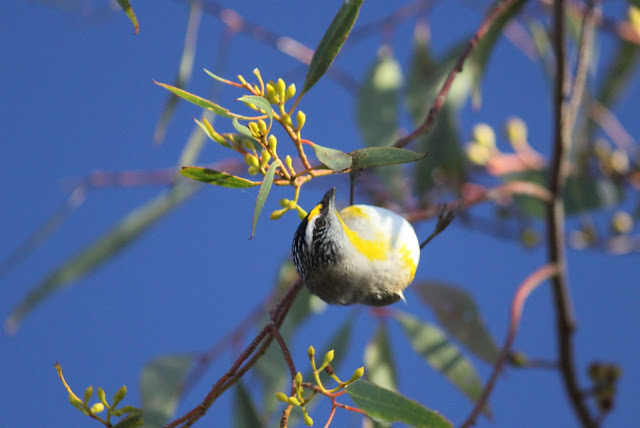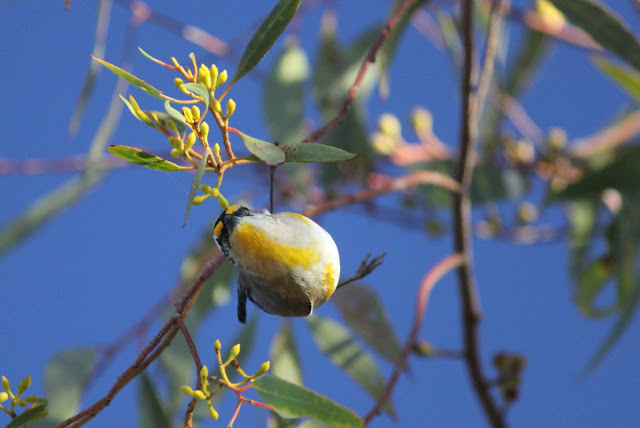Ruddy Turnstone - the bulldozer of the beach. Watching these birds seek out their prey is an awe inspiring experience. They have no trouble dislodging rocks the size of an adult males fist from the sticky, grey mud of the intertidal zone; often flipping them end over end, searching the hole left in the mud and then inspecting the faces and hollows of the rock itself in search of a tasty morsel. I had long believed that they wedged their closed bill under rocks in order to prise them out of the mud, but look closely at these images and you'll see that they are able to clamp their upper and lower mandible on the edges of a rock before giving it the heave ho'. Tonka tough.
SLAVE TO AVES
My own personal web-based blabbathon on all things loosely relating to the topic of birds!
Monday, September 10, 2012
Saturday, August 25, 2012
PHOTOGRAPHING 'BLIRREDS'...
Digiscoping....
....a real bugger at times.
An exasperating mix of photographing birds and 'blurred's'.
I have written about my folly with the camera and scope before. Sometimes I feel like I'm getting somewhere and other times I contemplate tossing it all into the sea.
I have slowly come to realise that digiscoping may be somewhat of a black art. When it comes to digiscoping one must patiently endure a protracted and mysterious courtship before one moves any closer to true love, eventual mastery and possibly eternal madness.
For me, different photographic styles and subjects have revealed themselves to be situated in very distinct categories or levels of difficulty.
For example, the 'bird on ground' type of shot seems to be the easiest way to manoeuvre the tripod, scope and camera and get resulting images that are of a satisfactory standard.
Second in its level of complexity is the 'bird in bush/tree' type of shot. This type of shot is usually hampered by the movement and activity of the bird, the depth of cover the bird can dive back into in an instant (usually just as you pull crystal clear focus...) and the frustrating knack that your digiscoping set up has in refusing to angle upward beyond 20 degrees toward said trees.
But by far, for me at least, the most awkward shot to successfully execute would have to be the 'bird in flight' type of shot. You're often up against the velocity with which the bird is travelling, the blinding glare of the sun (that you will no doubt find yourself staring into) as you stubbornly follow said bird with the scope and the 'up and down, side to side' freedom of movement that is flight.
Despite my inability to do anything right with this rig that I affectionately call 'Quasimodo' I do occasionally pull off the odd fluke and surprise myself with a cracking image or two.
....a real bugger at times.
 |
| Red Knot and one or two Curlew Sandpiper (like you couldn't tell!?) |
An exasperating mix of photographing birds and 'blurred's'.
I have written about my folly with the camera and scope before. Sometimes I feel like I'm getting somewhere and other times I contemplate tossing it all into the sea.
I have slowly come to realise that digiscoping may be somewhat of a black art. When it comes to digiscoping one must patiently endure a protracted and mysterious courtship before one moves any closer to true love, eventual mastery and possibly eternal madness.
For me, different photographic styles and subjects have revealed themselves to be situated in very distinct categories or levels of difficulty.
For example, the 'bird on ground' type of shot seems to be the easiest way to manoeuvre the tripod, scope and camera and get resulting images that are of a satisfactory standard.
Second in its level of complexity is the 'bird in bush/tree' type of shot. This type of shot is usually hampered by the movement and activity of the bird, the depth of cover the bird can dive back into in an instant (usually just as you pull crystal clear focus...) and the frustrating knack that your digiscoping set up has in refusing to angle upward beyond 20 degrees toward said trees.
But by far, for me at least, the most awkward shot to successfully execute would have to be the 'bird in flight' type of shot. You're often up against the velocity with which the bird is travelling, the blinding glare of the sun (that you will no doubt find yourself staring into) as you stubbornly follow said bird with the scope and the 'up and down, side to side' freedom of movement that is flight.
Despite my inability to do anything right with this rig that I affectionately call 'Quasimodo' I do occasionally pull off the odd fluke and surprise myself with a cracking image or two.
 |
| Caspian Tern Hydroprogne caspia |
 |
| Caspian Tern Hydroprogne caspia |
GULLS AIN'T GULLS....
Q: When is a Silver Gull not just a 'Seagull'?
...well, I think there's a certain majesty and a little bit of menace about a Gull as it quietly scours the detritus left behind by the small waves lapping on a deserted beach. It's even more interesting to see a group of three Gulls each displaying the various markings that delineate their age and rank. From the sinister, white-eyed glare and lipstick-red bills and legs of a fully mature adult to the smutty-flecked plumage and 'doe-eyed' appearance of the juvenile Gull - there's a gulf of cunning, devilment and street smarts between these generations of Gull.
Hated in city parks and suburban carparks and barely tolerated on our beaches, Silver Gulls cop quite a lot of flak form certain members of the biped population (and their pets). But, removed from the malarkey of of our urban confines and playgrounds the Silver Gull is a pretty awesome piece of purpose-built biology.
Just watch one do away with an unwitting crab in one or two strikes for evidence of how clever they really are.
...and then, of course, there's the famous interpersonal rivalries and relationship troubles.
Silver Gulls are good value in my book and worthy of some of our time and sympathy, they're even worthy of a few kind words and sympathetic photography too!
A BEVY OF BAR-WITS...
A miserable, dark and wet morning turned golden when I spied a small group of medium-sized waders feeding just offshore at Port Prime. The 'Prime' ain't usually such a great spot for birding as one's morning solitude can be shattered in an instant as caterwauling two-stroke trailbikes and single cylinder thumpers tear (illegally) across the claypans just east of the coast and a mere 100 metres or so from the fertile feeding grounds of this tidal beach. Despite this, I thought I'd pull in for a quick scout & count when I happened upon a small group of Bar-tailed Godwit feeding on a falling tide.
In 2007 a flock of Bar-tailed Godwit were tagged in New Zealand and then tracked on their migratory journey toward China. On route to China, one female that was tagged within that original flock, made a brief stop-over on the feeding grounds on the Yellow Sea before heading onward to Alaska. After reaching Alaska and staying there for the breeding season, she then departed Alaska on a non-stop flight from Western Alaska to New Zealand. This flight set a new known flight record of 11,680 kilometres.
To quietly watch these birds feed is also an amazing sight. They feed with rapid, precise jabs deep into the soft mud of the inter-tidal areas of our beaches. Beneath this layer of incredibly sticky mud lay a treasure trove of molluscs , worms and small crustaceans. The tip of a Godwits' bill is sensitive and can detect minute movements within the murky depths of the mud, over the course of a feeding and 'fattening' season the tip of the bill of many birds shows signs of wear; as they are steadily ground down over months of continuous feeding.
This species, as well as many other migratory waders, face enormous pressures as they continue to struggle to find space, resources and sanctuary today. Here in Australia, many of our 'recreational' pursuits, such a fishing, crabbing, driving on beaches (???) and the walking of dogs 'off of the leash', are potentially threatening to the flocks of waders that rely on our tidal mudflats for survival. The ability to feed undisturbed is critical to species, such as Bar-tailed Godwit, in making a successful return flight to their breeding grounds in Scandinavia, Alaska and Northern Asia. Bar-tailed Godwits have been known to double their body weight in the final month of feeding before departing Australian shores to begin their continuous northward flight.
I feel that if many Australian beach users were educated about the many other pressures faced by these birds in areas, such as the Yellow Sea in China, perhaps we could find it in our hearts to give them a little more space and respect their right to continue to feed and roost without disturbance as they have done for many, many years.
Viva La Barwit.
Saturday, August 11, 2012
"PIED OY, MATE!..."
It has been a few months since my last post. I have still managed to get out birding at least once every 3 weeks but a recent computer virus deleted the bulk of my archive of photographs taken between May and August, including some nice photos of a pair of Whimbrel in company with 8 Eastern Curlew at Thompson Beach. Dang! These things happen - if anyone out there has a sure-fire way to retrieve these 'lost' files, please drop me a line. It took a good day or two to get over the disappointment of losing 400+ pictures.
Well, onto brighter news. Late Winter has proven to be quiet around the northern shores of Adelaide. I journeyed out to Thompson Beach on high tide this morning to scout for any recent arrivals from north of the Equator. I was treated to a small number of post-breeding, recently-landed Curlew Sandpiper feeding frenetically on the claypans just north of town. Their small posse was flanked by 200+ Red-necked Stint, a big jump in numbers since my last visit three weeks ago. In the same area a group of 16 Double-banded Plover were keeping a low profile among the dead Samphire cover in the middle of the shallow water.
With so few waders about I turned my attention to some of the birds I usually scurry past on my way to look for other things deemed more 'exotic'. It was nice to slow the pace of travel for a morning, instead of marching about madly like an ape trying to shift a large suppository, I took the time to sit and observe, note and photograph.
It was a nice change to casually observe the behaviour of a few of the more common birds found on shore, such as the Great Egret, Crested Tern, Silver Gull and Pied Oystercatcher. In my new-found 'zen' state I was treated to a few special moments of what I call 'birding serendipity'.
Whilst scanning a large group of Crested and Caspian Tern I was lucky to find a group of 3 Fairy Tern almost obscured by rocks and larger birds. Patience and quiet observation pays off. Seeing these delicate and graceful little birds makes any day out a great day out - considering their current conservation status is currently listed as 'vulnerable' according to the International Union for Conservation of Nature (IUCN). I hope that I may continue to stumble upon this species at this site for many more years to come.
The constant calling of a juvenile Crested Tern caught my attention and I was treated to a prolonged display of Avian paternal patience of the highest order. For close to 10 minutes I watched a young Crested Tern subject its parent to the Avian equivalent of 'pester power'. I shuddered with horror as I was momentarily transported back to similar feed time shenanigans around the dinner table with my very own squawking fledglings.
"Gimme, gimme, gimme...."
"I know you heard me....now GIMME!"
"Hey! Wait!...errr Mum, where are you going?"
"Mama?"
The final 'treat' of the day, and inspiration for the title of this here entry, came as I headed back toward the car at midday. A pair of Pied Oystercatchers gave me some sustained close views and a little more than I bargained for...
Not everyday you see that.
Until next time...
Tuesday, May 22, 2012
NATURE'S TINY GYMNAST...
The Striated Pardalote - greatly underrated and often elusive mini-champ of the Australian bush. Not usually a difficult species to track down; but given its preference for high foliar foraging, it can prove to be a hard bird to get 'eye to eye' with. I was lucky enough to have a close encounter with this species at Monarto Zoological Park on the eastern slopes of the Mount Lofty Range outside of Adelaide, SA. The many fine examples of low-slung Mallee that dominate the canopy of this site allow great opportunities to get close to this supercharged little bird. I was lucky enough to capture some of the many twists and turns these birds execute as they frenetically scoot through the upper reaches of trees in search of their meal of choice - Lerps.
Lerps, the sugary coating that serves as protection for psyllid insect larvae, serve as the perfect high-octane fuel to power the 'never still' Pardalote family. Given the right habitat, you'll often hear the tell-tale 'flicking' sound of a tiny, purpose-built bill as it pecks methodically to liberate many a Lerp from its leaf. If you take the time to follow the sound, you may be treated to an amazing display from one of nature's tiny gymnasts. Captivating stuff!
Lerps, the sugary coating that serves as protection for psyllid insect larvae, serve as the perfect high-octane fuel to power the 'never still' Pardalote family. Given the right habitat, you'll often hear the tell-tale 'flicking' sound of a tiny, purpose-built bill as it pecks methodically to liberate many a Lerp from its leaf. If you take the time to follow the sound, you may be treated to an amazing display from one of nature's tiny gymnasts. Captivating stuff!
Subscribe to:
Posts (Atom)














































